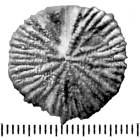
| Intro | | About | | Wiki | | Search traits | | Data explorer | | Literature | | Definitions | | Sources | | Webservices | | Statistics | | Feedback | | Editors | | Log in |
WoRMS taxon detailsStelloria d'Orbigny, 1849 †
1455812 (urn:lsid:marinespecies.org:taxname:1455812)
accepted
Genus
Stelloria elegans d'Orbigny, 1850 † (type by subsequent designation)
marine,
fossil only
Orbigny, A. D. d'. (1849). Note sur des Polypiers fossiles. <em>Revue et Magasin de Zoologie, 2e sér.</em> 1: 526-538. [details]
Hoeksema, B. W.; Cairns, S. (2024). World List of Scleractinia. Stelloria d'Orbigny, 1849 †. Accessed through: World Register of Marine Species at: https://www.marinespecies.org/aphia.php?p=taxdetails&id=1455812 on 2024-06-07
original description
Orbigny, A. D. d'. (1849). Note sur des Polypiers fossiles. <em>Revue et Magasin de Zoologie, 2e sér.</em> 1: 526-538. [details]
basis of record Löser H. (2014). Nomenclatural note about the fossil coral genus Coelosmilia (Cretaceous. <em>Palaeodiversity.</em> 7: 129-132. [details] additional source Duncan PM (1884) A revision of the families and genera of the sclerodermic Zoantharia, Ed. & H., or Madreporaria (M. Rugosa excepted). Journal of the Linnean Society of London, 18: 1-204. [details]  Present Present  Inaccurate Inaccurate  Introduced: alien Introduced: alien  Containing type locality Containing type locality
From editor or global species database
Diagnosis Solitary, turbinate, fixed. Costosepta compact, with strong vertical striations or carinae projecting halfway to adjacent septa or fusing with them. Costae reduced. Columella and pali absent. Endothecal dissepiments sparse. [details]Remark Recently, a paper was published by Loeser (2014d) on the genera Stelloria and Coelosmilia. In this paper, numerous erroneous statements are made:...... 1) according to Loeser, the genus Coelosmilia was established twice: once by d'Orbigny, 1850, and again by Milne Edwards and Haime, 1851........ This statement is incorrect as the genus Coelosmilia was established by Milne Edwards and Haime in 1850, p. XXV (not 1851; see, e.g., Biodiversity Heritage Library for publication date), whereas d'Orbigny (1850, p.181) only assigned the species Anthophyllum sulcatum Michelin, 1846, to Milne Edwards and Haimes genus (d'Orbigny clearly refers to Milne Edwards and Haime as the authors of Coelosmilia). Therefore, the statement by Loeser (2014d, p. 130) that Anthophyllum sulcatum Michelin, 1846, is the type species of Coelosmilia is incorrect. The designation of the type species of the genus Coelosmilia was carried out by Milne Edwards and Haime (1850, p. XXV), clearly naming the taxon Parasmilia porculum as the type species of their genus. ...... 2) """the taxon created by Milne Edwards and Haime, 1851, represents a nomen dubium because the locality of the type species is unknown and the type specimen is not available.""" ...... This statement is incorrect as the status of a nomen dubium is defined by the lack of an adequate taxonomic characterization ("a name of unknown or doubtful application") but is dependent neither on designation of a type locality nor on the availability of type material. Therefore, statements such as “Coelosmilia MILNE EDWARDS and HAIME, 1851 is a nomen dubium. Stelloria ORBIGNY, 1849 is a nomen dubium, but it may be confused with Coelosmilia ORBIGNY, 1850 and could be a senior synonym of this genus.” (Loeser, 2014d, p. 131) are beyond comprehension. ..... 3) """the genus Stelloria d'Orbigny, 1849, is a nomen dubium.""" ..... This statement is incorrect. While it remains unclear on which facts this statement is based, it is assumed that Loeser (2014d, p. 131) based his assumption on the study of the specimen MNHN A26585 (=# 6707, original number) of the d'Orbigny collection, which may or may not correspond to the genus concept of Stelloria. However, Wells (1936, p. 130) clearly based the genus concept on the specimen # 6703 of the d'Orbigny collection which, according to Wells, is identical to the taxon Anthophyllum sulcatum Michelin (1846, p. 197, pl. 50. figs. 5a-c). Therefore, the genus Stelloria can be clearly taxonomically identified and is not a nomen dubium, regardless of whether or not the type material is available. [details] |


